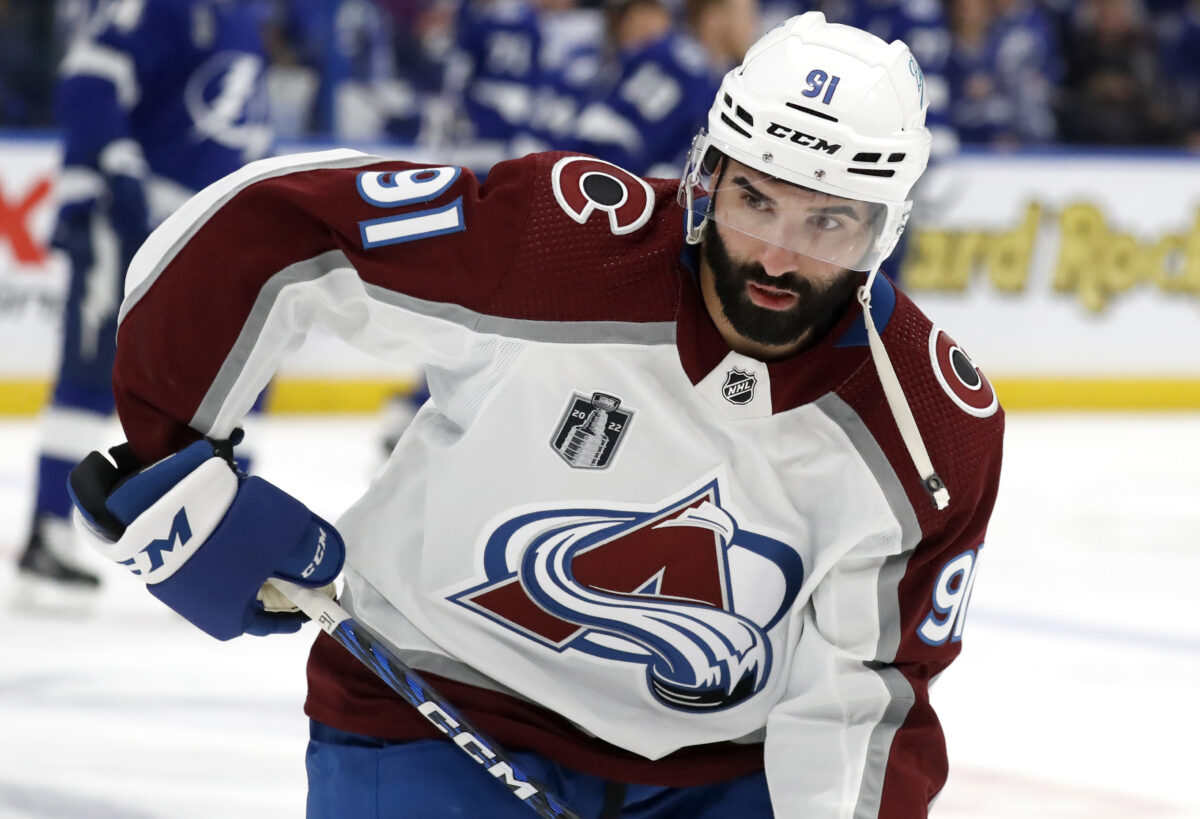Although the 2021-22 edition of the Colorado Avalanche just missed out on collecting a second consecutive Presidents’ Trophy, their play this season has warranted comparisons to the heralded 2000-01 outfit. That year’s team held the previous franchise record for wins and points in a single campaign, both broken by the current collection of Avalanche talent. On top of their regular-season excellence, the 2021-22 group claimed the third Stanley Cup in franchise history, conquering the Tampa Bay Lightning in the Final, a team looking to cement their legacy as a modern-day dynasty with three consecutive titles.

It’s impossible to fully compare the two, but that won’t stop me from proclaiming the 2021-22 team as the best version ever iced in the franchise’s brief, but storied history. From successfully navigating unfortunate injury luck, boasting unparalleled offensive depth, and slaying a dynasty, coach Jared Bednar’s charges stand alone. Let’s dig into how the two squads – separated by two decades – compare in a number of regular-season and playoff statistical categories.
2000-01 vs. 2021-22 Avalanche: Regular Season Comparison
The first statistical arena in which these two iterations are to battle is in the regular season sphere. The 2000-01 team previously held the franchise record in both wins (52) and points (118), spearheaded by a number of Hall-of-Fame talents in Joe Sakic, Patrick Roy, Peter Forsberg, Ray Bourque, and Rob Blake. Those marks stood until this past season, in which the Avalanche, led by Nathan MacKinnon, Gabriel Landeskog, Mikko Rantanen, and Cale Makar, set new benchmarks in wins (56) and points (119). While accounting for the shootout, which didn’t exist during the 2000-01 season, the 2021-22 team tied the previous records for regulation victories (46) and total wins including those settled in overtime (52). As the following table suggests, the two units grade out as remarkably similar in terms of on-ice results.
Latest THW Headlines
| 2000-01 | Metric | 2021-22 |
|---|---|---|
| 52 (1) | Wins | 56 (2) |
| 52 (1) | Regulation/Overtime Wins | 52 (3) |
| 46 (1) | Regulation Wins | 46 (2) |
| .720 (1) | Points Percentage | .726 (2) |
| 56.1 (2) | Shot Share (%) | 52.3 (9) |
| 58.4 (2) | Goal Share (%) | 57 (4) |
| .907 (10) | Save Percentage | .912 (6) |
Even so, the 2000-01 team posted stronger numbers in all situations, ranking second in both their share of shots and goals scored during the regular season. Interestingly enough, the 2021-22 Avalanche received better goaltending relative to the rest of the league, finishing sixth in team save percentage (SV%) largely due to a Vezina Trophy caliber season from Darcy Kuemper (.921 SV%; fifth in goals saved above expected – GSAx). In diving a bit deeper into their even-strength results, the teams nudge even closer to one another in the franchise hierarchy.
| 2000-01 | Metric | 2021-22 |
|---|---|---|
| 53.1 | Shot Share (%) | 52.2 (9) |
| 2.18 (4) | GF/GP | 2.51 (5) |
| 1.61 (4) | GA/GP | 1.93 (8) |
| 57.6 (2) | Goal Share (%) | 56.6 (5) |
Given that league-wide shot metrics were not made readily available until the late-2000s, I manually combed through the 2000-01 team’s game sheets to calculate their results. For reference, the 2000-01 team’s 53.1% even-strength shot share would rank seventh in the league this season. Both teams managed to control the run of play and were similarly prolific in their attack. Both squads finished within the top five in goals per game, but the 2000-01 group conceded the fourth-lowest rate of goals against per game which was a notch above its modern competition.
Delving further, each team’s results on special teams only add to the growing similarities. Both finished within the top five of powerplay efficiency and top two in goals per game with the man advantage. With the number of offensive weapons present on both rosters, those numbers should come as no surprise. Interestingly, both shared a certain malaise when it came to the penalty kill, finishing in the bottom half leaguewide in terms of their shorthanded success.
| 2000-01 | Metric | 2021-22 |
|---|---|---|
| 22.0 (3) | PP% | 25.8 (4) |
| 0.98 (2) | PPG/GP | 0.86 (1) |
| 82.8 (19) | PK% | 79.3 (16) |
| 0.72 (13) | PK GA/GP | 0.59 (16) |
Both teams posted robust on-ice numbers at even strength on their way to finishing atop the regular-season standings, often pummeling opponents due to their embarrassment of riches throughout the lineup. Where the 2021-22 Avalanche start to pull ahead is how many reliable offensive contributors they boasted at every position, at a level unrivalled by any other team in the league.
Offensive Depth Sets 2021-22 Avalanche Apart
Although discrepancies in historical scoring rates make it difficult to directly compare the offensive outputs of the two teams, their results relative to the rest of the league can provide context. Using a 65-point pace as a filter, the 2000-01 team was one of the NHL’s more potent attacking units. With five players producing at the aforementioned rate (Bourque, Chris Drury, Forsberg, Milan Hejduk, Sakic, and Alex Tanguay), the Avalanche tied for second in the league in that regard.
You may also like:
- Colorado Avalanche Won’t Be Contenders This Season
- Colorado Avalanche Lineup Projection for 2024-25
- Avalanche Giving Nikolai Kovalenko a Chance to Prove Himself
- 3 Avalanche Players With the Most to Prove in 2024-25
- Peter “Foppa” Forsberg: A Biography
Moving to the 2021-22 team, I lowered the threshold to a per-game rate of 0.75 points, with a minimum of having played at least half of the season. Under this filter, the Avalanche boasted eight such players, two more than the second-best teams. Apart from the stars, Kadri, Valeri Nichushkin, and Andre Burakovsky, all enjoyed career years, adding to Colorado’s unparalleled scoring depth up and down the lineup.
A more appropriate comparison can be made when not abiding by a specific points-per-game (P/G) standard, but by their standard relative to the rest of the league. The 2021-22 Avalanche had four players finish in the top 25 by P/G (the most in the league), and five in the top 50. Comparatively, the 2000-01 unit had two in the top 25 but also boasted five in the top 50. Both teams fashioned elite regular seasons on the back of star power and capable depth to roll over opponents. Even with their equivalent tiers of talent, the health issues experienced by the 2021-22 team make their achievements that much more impressive.
Success Despite Poor Injury Luck Pushes 2021-22 Avalanche Ahead
Despite the two teams posting eerily similar statistics, the 2021-22 edition dealt with a handicap not experienced by the 2000-01 group. Whether it’s due to a compressed schedule brought on by the pandemic or plain bad luck, the Avalanche navigated an injury-filled campaign en route to their most successful regular season in franchise history.
The 2000-01 team had a relatively pristine record of health, with Drury (11 games) and Forsberg (nine) as the only members of their key contributing group missing more than two games on the season. In comparison, Landeskog (31 games), MacKinnon (17), Devon Toews (16), Nazem Kadri (11), and Makar (five) all eclipsed that mark this past season. That this year’s club still managed to set organizational records in several categories speaks to the overall strength of the roster. If we consider both teams at full health, the 2021-22 edition likely climbs even higher over its revered predecessor.

It becomes extremely difficult to develop chemistry and gain familiarity with the team strategies and play style without consistency in the lineup. That the 2021-22 team broke franchise records in spite of a steadily rotating cast of players on a nightly basis lends more credence to the argument that they are now the franchise’s best outfit. Whether it was a superstar or a bottom-line grinder who was absent, the Avalanche plugged in any number of replacements and still rattled off strong results, a resounding testament to their overall excellence.
2000-01 vs. 2021-22 Avalanche: Playoff Comparison
Understandably, fans place a greater emphasis on postseason results than those from the regular season, as the stakes are higher and the competition is stiffer. The 2000-01 Avalanche went 16-7 en route to the Stanley Cup, beating the Vancouver Canucks (15th in the NHL), Los Angeles Kings (13th), St. Louis Blues (sixth), and New Jersey Devils (second) along the way. The 2021-22 version faced a similar calibre of opponents in their run, casting aside the Nashville Predators (16th), Blues (ninth), Edmonton Oilers (11th), and the Lightning (seventh) in the process of completing their championship journey.
Forsberg (89 points in 73 games), only played in 11 of the 23 games during Colorado’s run due to a ruptured spleen. Despite losing the Swedish star for the final two rounds, the Avalanche managed to overpower the Devils in the Cup Final. They’re not equivalent, but the 2021-22 Avalanche were without the services of Samuel Girard (played in seven out of 20) and Kadri (16 out of 20) for a good chunk of the postseason.

Both teams stared down injuries to significant parts of their lineup and watched as their depth pieces stepped up. While each of Nichushkin (15 points in 20 games), Artturi Lehkonen (14 in 20), Burakovsky (eight in 12), J.T. Compher (eight in 20), Andrew Cogliano (six in 16), and Darren Helm (five in 20) added offense in 2021-22, the primary stars on the 2000-01 team were buoyed by the contributions of a young Drury (16 in 23), Ville Nieminen (10 in 23), and Dan Hinote (six in 23).
In 2001, Sakic led the Avalanche in postseason scoring, tallying 26 points (13 goals and 13 assists) in 21 games. Makar eclipsed that total for the 2022 club, producing 29 points in 20 games as a 23-year-old, and winning the Conn Smythe Trophy as playoff MVP. Five different players on the 2021-22 team scored at a point-per-game clip, while the 2001 edition only had three such individuals.
The biggest difference between the two teams comes in net where Patrick Roy posted a .934 SV% in 23 games. The 2022 Avalanche clearly lacked a Hall-of-Fame level talent in the crease, with Darcy Kuemper as the starter with a .902 SV%. The 2021-22 Avalanche scored 4.25 goals per game in the playoffs and owned a 60.7 goals for percentage (GF%) in all situations. The 2001 team only generated three per game but rode a stronger goaltending performance from Roy to a 62.7% all-situations goal-share.
The 2000-01 team struggled mightily at even strength in two of their four series, needing Roy to bail them out on multiple occasions. They only posted a 47% shot share against the Blues and stumbled against the Devils in the Cup Final, winning the title despite accruing a paltry 41% share of shots on goal.
It’s a direct contrast to the 2022 Avalanche’s relationship with Kuemper, where a super-powered offence rendered discussions about who occupied the crease moot. Against the Lightning, the Avalanche recorded 58.3% of all shots on net at even strength, but only accounted for 50% of goals scored. Kuemper’s .892 SV% nearly incapacitated the Avalanche in the Cup Final, but their blistering power play was enough to overcome their struggles in the crease.
Since the league instituted the 16-win format beginning with the 1987 Playoffs, only six teams have ever finished the postseason with a record of 16-4 or better. The 2021-22 Avalanche were the first team since the 2011-12 Los Angeles Kings to achieve the feat. Of the six, Colorado posted the third-highest GF% (60.7%) in all situations. The 2000-01 team lost three additional games but posted a slightly higher share of goals (62.7%).
| 2000-01 | 2021-22 | |
|---|---|---|
| Shot share | 49.6% | 58.6% (1) |
| All-Situations Goal share | 62.7% (1) | 60.7% (1) |
| PP% | 19.8% (6) | 32.8% (1) |
| PK% | 85.9% (5) | 80.4% (7) |
Apart from their lower GF% (which can be explained by Kuemper’s inconsistency), the 2021-22 team performed better in most respects. They dominated the shots battle and the Avalanche’s incendiary power play converted at the seventh-highest rate in NHL history (minimum eight playoff games), scoring on almost a third of their opportunities. Their penalty kill was around average, but their offensive prowess more than made up for their shortcomings while shorthanded. Ultimately, the two most successful teams in the franchise grade out similarly in almost every possible department. Still, the most recent Avalanche squad climbs ahead just enough to claim the all-time honor.
2021-22 Avalanche Edge Out 2000-01 Team For All-Time Best Honour
Against the backdrop of COVID-19 and the stringent rules surrounding roster construction in the salary cap era, the 2021-22 Avalanche set a number of franchise records previously established by the 2000-01 team. Given the historical importance placed on postseason results, and that the most recent iteration of the franchise could slay their demons and match their predecessors with a Stanley Cup championship, pushes them ever so slightly ahead in this debate. It remains to be seen how many Hall-of-Fame players emerge from the 2021-22 squad, but they grade out as the stronger all-around unit.
Sound off in the comments; where do the 2021-22 Avalanche stand among the greatest teams in franchise history? Is recency bias exercising its influence, or is this team’s greatness just so apparent that it usurps the 2000-01 squad?
Data courtesy of Evolving Hockey, Hockey Reference, and the NHL.
